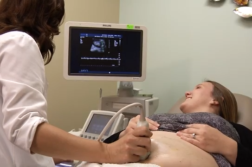CLEVELAND, Ohio (Ivanhoe Newswire)— Congenital pulmonary airway malformation, also called C-PAM, is a rare birth defect that only occurs in up to one in every 35,000 births, causing a mass to form on the lung of a fetus. This condition can also be accompanied by hydrops, where fluid builds up in a baby’s tissue causing extreme swelling as well as excess fluid inside the placenta. And in cases of C-PAM with hydrops—95 percent of babies die before, or soon after, birth. Now, learn about a breakthrough procedure for one family that was preparing for the worst. Surgery during birth.
Adrianna Mashburn and her husband, Micah, were getting everything ready to welcome little Maverick into the world when a third-trimester checkup turned their world upside-down.
Maverick was diagnosed with congenital pulmonary airway malformation or C-PAM. A mass was crushing Maverick’s lungs, heart, and esophagus.
“Things can just go wrong, and Maverick’s heart could stop. He’s got a big mass in his chest, he’s hydropic, there’s a risk that he could die,” described Darrell Cass, MD, director of fetal surgery at Cleveland Clinic.
Then at 37 weeks—almost full term—mom and baby had EXIT-to-resection surgery. Maverick was partially delivered allowing Dr. Cass to open his chest and remove the mass, all while Maverick was still receiving oxygen from his mother through her umbilical cord.
“Maverick’s surgery was very tricky,” Dr. Cass recalled.
Halfway through surgery—Adrianna’s placenta started to fail. Doctors delivered Maverick and cut the cord, but the newborn’s airway was already secure.
“We stabilized him and then I completed the surgery to remove this mass,” Dr. Cass explained.
Maverick thrived after surgery and Adrianna …
“Recovered beautifully! She was there at Maverick’s bedside right away,” Dr. Cass expressed.
Doctors say one challenging part of this procedure is maintaining placental blood flow. This requires an experienced anesthesia team to keep mom asleep and her uterus relaxed throughout surgery.
Contributors to this news report include: Cyndy McGrath, Executive Producer; Sabrina Broadbent, Field Producer; Roque Correa, Editor.
To receive a free weekly e-mail on Medical Breakthroughs from Ivanhoe, sign up at: http://www.ivanhoe.com/ftk
Sources:
https://www.ncbi.nlm.nih.gov/books/NBK551664/
https://www.karger.com/Article/Fulltext/440894#:~:text=A%20survival%20rate%20of%20more,hydrops%20managed%20expectantly%20%5B51%5D. https://my.clevelandclinic.org/patient-stories/409-surgery-removes-large-mass-on-babys-lung-before-birth)
MEDICAL BREAKTHROUGHS
RESEARCH SUMMARY
TOPIC: SURGERY DURING BIRTH: SAVING BABY MAVERICK
REPORT: MB #4839
BACKGROUND: Congenital pulmonary airway malformation, also called CPAM, is a mass of abnormal tissue that forms within the fetus during pregnancy. Babies can have one or more lesions, typically located on only one lung, that can be solid or filled with fluid, and they do not function as normal lung tissue. These lesions can vary in size and appearance as well as change dramatically over the course of the pregnancy. The cause of CPAM is unknown and is not hereditary or passed down through family genetics. Another separate, but often accompanying condition, is called Hydrops Fetalis which occurs when large amounts of fluid build up in a baby’s tissues and organs while in the womb, causing extreme swelling. Hydrops can be broken up into two categories. Immune, which occurs when a mother’s immune system causes her baby’s red blood cells to break down and is the most dangerous complication of newborn hemolytic disease. Non-immune occurs when disease or other complications interfere with the baby’s ability to manage fluid; it is the most common type of hydrops.
(Sources: https://www.cincinnatichildrens.org/service/f/fetal-care/conditions/congenital-pulmonary-airway-malformation, https://www.karger.com/Article/Fulltext/440894#:~:text=A%20survival%20rate%20of%20more,hydrops%20managed%20expectantly%20%5B51%5D,
DIAGNOSING: A CPAM is typically diagnosed during prenatal checkups and detected by ultrasound. It appears as a bright mass in the chest cavity where only lung tissue should be seen. Doctors confirm diagnosis by using an advanced fetal MRI to better visualize and identify the location of the malformation. They may also perform a fetal echocardiogram, also called an echo, to rule out in cardiac defects and asses the functionality of the heart. Hydrops is also diagnosed via ultrasound during prenatal checkups. Ultrasound allows doctors to see if there is abnormal or increased fluid collection in a at least two fetal body spaces to diagnose. If fluid accumulation is only occurring in one area, doctors cannot make the diagnosis of hydrops and the build-up is just noted. To differentiate between immune and non-immune, the mother will undergo a blood test that looks for antibodies associated with blood-group incompatibility.
(Sources: https://www.ssmhealth.com/cardinal-glennon/fetal-care-institute/lungs/congenital-pulmonary-airway-malformation, https://childrenswi.org/medical-care/fetal-concerns-center/conditions/infant-complications/hydrops-fetalis-erythroblastosis-fetalis#:~:text=Doctors%20diagnose%20hydrops%20prenatally%20using,make%20the%20diagnosis%20of%20hydrops)
NEW TECHNOLOGY: CPAM can severely complicate birth if there is a large mass. Now, doctors can perform exit-to-resection surgery in which the baby is partially delivered while still receiving oxygen and expelling carbon dioxide through the umbilical cord. After partial delivery, surgeons can open the baby’s chest and remove the mass. This is a high-risk and complicated surgery that requires a team of experts in cardiology, maternal fetal medicine and obstetric anesthesia. During exit-to-resection surgery, the anesthesia team must keep mom under a deep general anesthesia to keep the uterus relaxed while it is opened and to preserve uterine placental blood flow. If the uterus contracts it tends to constrict the uterine blood flow.
FOR MORE INFORMATION ON THIS REPORT, PLEASE CONTACT:
HOPE BUGGEY
If this story or any other Ivanhoe story has impacted your life or prompted you or someone you know to seek or change treatments, please let us know by contacting Marjorie Bekaert Thomas at mthomas@ivanhoe.com




